Learn how to make sushi rice perfectly every time with step-by-step pictures and a video tutorial. All you need are simple ingredients such as rice vinegar, sugar, salt, and kombu. Once you master the secret of making the sushi rice, you will be ready to dish up all kinds of mouth-watering sushi recipes!
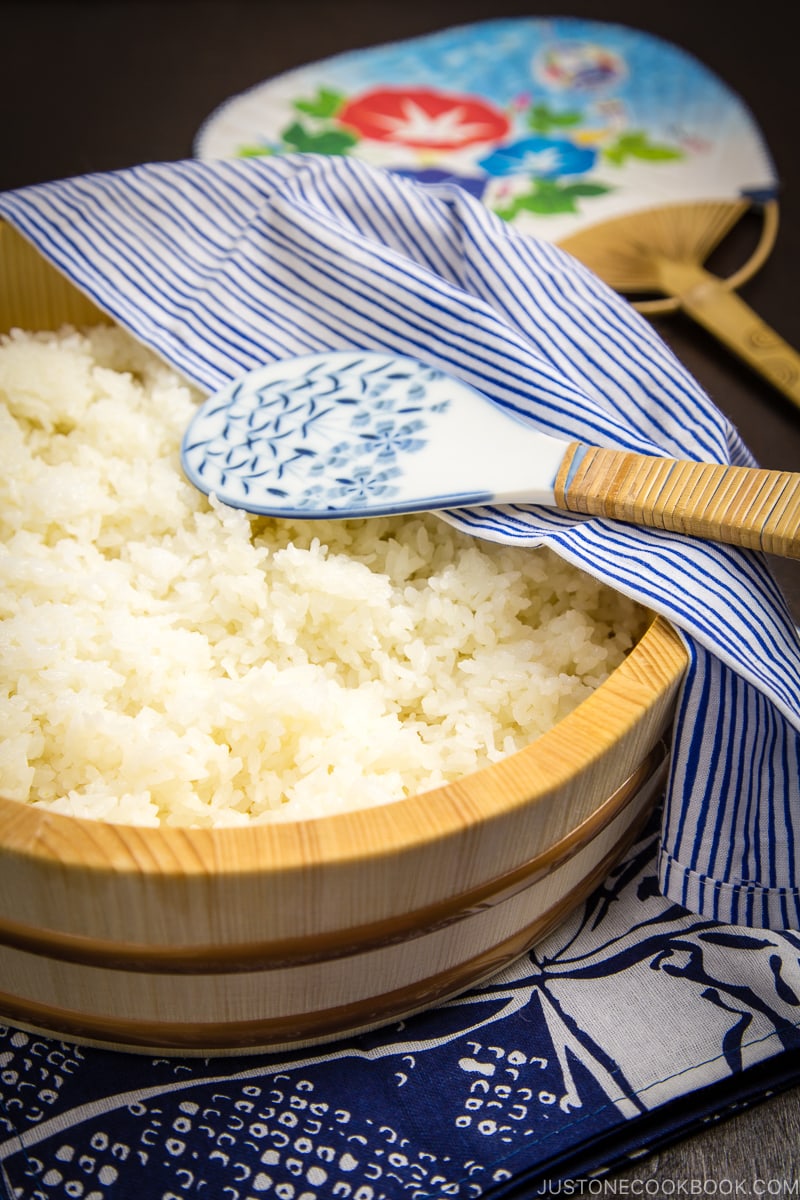
Servings: 5 (5¼ US cups, 990 g; see below)
Ingredients
★ For 5-6 Servings of Sushi Rice (Makes 7-11 Sushi Rolls)
- ▢ 3 rice cooker cups uncooked Japanese short-grain rice (540 ml, 2¼ US cups, or 450 g for 5-6 servings; this yields 5¼ US cups (990 g) of cooked rice; you must use Japanese short-grain rice or your sushi will fall apart)
- ▢ 2¼ US cups water (540 ml for 5-6 servings)
- ▢ 1 piece kombu (dried kelp) (5 g; 2 inches x 2 inches, 5 cm x 5 cm; optional—but it will give a nice aroma!)
- ▢ ⅓ cup sushi vinegar (seasoned rice vinegar) (available at a Japanese/Asian grocery store or make the homemade recipe below)
Optional: Homemade Sushi Vinegar (for 3 Rice Cooker Cups)
- ▢ ⅓ cup rice vinegar (unseasoned)
- ▢ 3 Tbsp sugar
- ▢ 1½ tsp kosher salt (Diamond Crystal; use half for table salt)
★ For 3-4 Servings of Sushi Rice (Makes 5-7 Sushi Rolls)
- ▢ 2 rice cooker cups uncooked Japanese short-grain rice (360 ml, 1½ US cups, or 300 g for 3-4 servings; this yields 3½ US cups (660 g) of cooked rice)
- ▢ 1½ US cups water (360 ml for 3-4 servings)
- ▢ 1 piece kombu (dried kelp) (5 g; 2 inches x 2 inches, 5 cm x 5 cm; optional—but it will give a nice aroma!)
- ▢ 4 Tbsp sushi vinegar (seasoned rice vinegar) (available at a Japanese/Asian grocery store or make the homemade recipe below)
For Homemade Sushi Vinegar (Optional; for 2 Rice Cooker Cups)
- ▢ 4 Tbsp rice vinegar (unseasoned)
- ▢ 2 Tbsp sugar
- ▢ 1 tsp kosher salt (Diamond Crystal; use half for table salt)
Japanese Ingredient Substitution: If you want substitutes for Japanese condiments and ingredients, click here.
Instructions
- Before You Start: Please note that we measure the uncooked rice with a rice cooker cup; 1 rice cooker cup is 180 ml, ¾ US cup, or 150 g. We measure the water with a standard US measuring cup; 1 US cup is 240 ml. 1 rice cooker cup of uncooked rice is 150 g (5.3 oz) and yields roughly 330 g (11. 6 oz) of cooked rice, which is roughly 1¾ US cups. One sushi roll requires 90-135 g or ½-¾ US cup of sushi rice.
- Measure the Rice: Overfill a plastic rice cooker cup (or ¾ US cup measure) with uncooked short-grain rice and level it off. Put the rice in a large bowl. Repeat until you have the amount of measured rice needed.
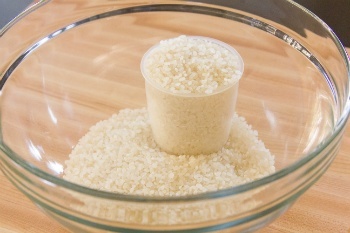
- Gather all the ingredients.
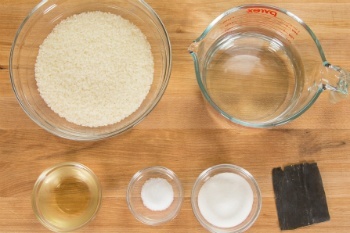
To Wash and Cook the Rice
- Quick Rinse: Add just enough water to submerge all the rice. Then, discard the water immediately. Repeat one more time. Tip: Rice absorbs water very quickly when you start rinsing, so this step helps remove impurities from the rice and prevent it from absorbing the first few rounds of milky water.
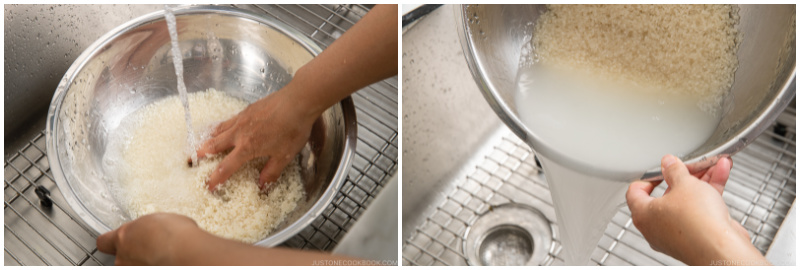
- Wash: Next, use your fingers to gently agitate the wet rice grains in a circular motion for 10-15 seconds. Using very little water allows the grains to rub against each other. It also reduces the absorption of impurities from the milky water.
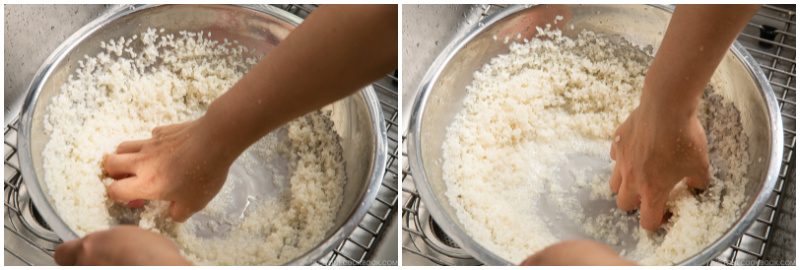
- Rinse: Add water and immediately discard the cloudy water. Repeat one more time.Repeat Wash and Rinse (steps 2 and 3) two more times.
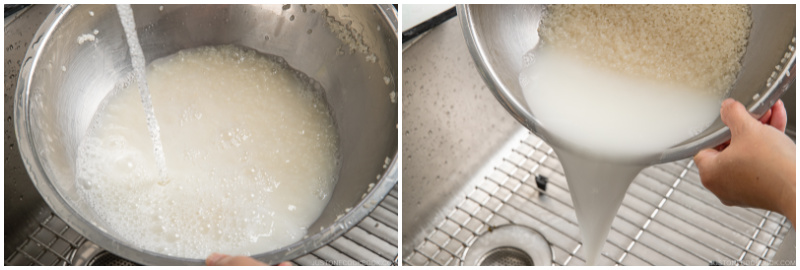
- Drain: When the water is almost clear, drain the rice very well. Tip: Use a fine-mesh sieve to drain and shake off any excess water.
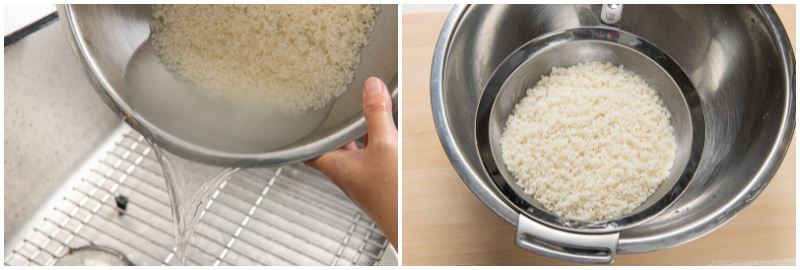
- Check the kombu to see if there are any dirt particles. If needed, gently wipe it off with a damp cloth (it’s a traditional method but these days kombu is pretty clean). Do not wipe off the white powdery substance, which contributes to the umami flavor. NEVER wash the kombu!
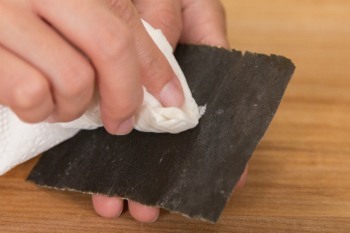
- Soak and Cook: Put the well-drained rice in the rice cooker bowl and add the measured water to just under the 3-cup line for White Rice. If your rice cooker has a Sushi Rice mode, add water up to that line. Place the kombu on top of the rice and let the rice soak in the water for 20-30 minutes. Then, start cooking. If you don’t have a rice cooker, cook the rice in a pot over the stove, Instant Pot, or donabe with the amount of water I specified in this recipe. Tip: Since we’ll be adding sushi vinegar to the steamed rice, cook the rice a little bit on the firm side. To achieve this, use a rice-to-water ratio of 1 to 1 for sushi rice (instead of 1 to 1.1 or 1 to 1.2 for regular steamed rice).

To Make the Sushi Vinegar (Optional)
- If you are not using a store-bought bottle of sushi vinegar (seasoned rice vinegar), follow this step. Combine the rice vinegar, sugar, and salt in a small saucepan and bring it to a boil over medium-high heat. Whisk until the sugar is completely dissolved. You can also put the ingredients in a microwave-safe bowl and microwave for 1 minute, or until the sugar is dissolved. Set aside to let it cool.
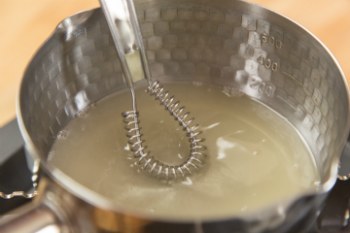
To Make the Sushi Rice
- If using a wooden sushi oke (also called hangiri), moisten it by running water over it and drain well. You can also use a baking sheet lined with parchment paper. When the rice is cooked, discard the used kombu (or repurpose it to make simmered kombu) and transfer the cooked rice into the sushi oke. Spread out the rice evenly so it will cool faster. While it’s hot, pour the sushi vinegar over the rice. Tip: You can still use this same amount of sushi vinegar whether you are making a bit more or less sushi rice. Take note that we add roughly 8-10% of the cooked rice weight in sushi vinegar.
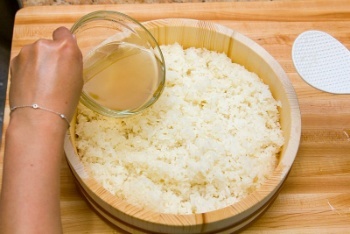
- With a rice paddle, gently “slice” the rice at a 45-degree angle to incorporate the sushi vinegar mixture and separate the chunks of rice. Do not stir or mix the rice because the grains may break and the rice will become mushy. While using this slicing motion, vigorously fan the rice with a paddle fan or another type of fan. This cools the rice and takes away the excess moisture. Fanning makes the rice shine and keeps it from becoming mushy.

- Then, gently flip the rice in between slices. Repeat this process until the rice is cooled to the temperature of human skin.

To Keep
- Keep the sushi rice covered with a damp towel (or paper towel) for a few hours at room temperature. To keep it for a longer time, see below.
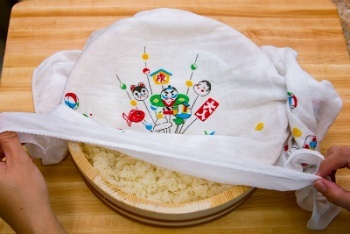
To Store
- Rice gets hard and dry in the refrigerator. My recommendation is to put the sushi rice in an airtight container and store it in the freezer for up to a month. You can defrost it overnight in the fridge, and then microwave to room temperature (not hot). If you really want to refrigerate it, cover the container with a thick kitchen towel, so the rice will stay cool but not become cold.
From: Just One Cookbook